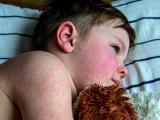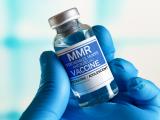In its regular weekly update, the US Centers for Disease Control and Prevention (CDC) today reported 22 more measles cases, bringing the total so far this year to 1,044 cases, the most since 1992 and since the disease was declared eliminated in 2000.
In a related development, experts from the CDC writing in Pediatrics today detailed recent patterns regarding the spread of measles in Europe, consequences for travelers, and advice for clinicians.
Five US outbreaks still active
The weekly number of cases is down from the 41 reported during each of the previous 2 weeks, and the number of ongoing outbreaks declined from seven to five, according to the CDC's update. The number of affected states remained at 28.
The currently active outbreaks are in New York's Rockland County; New York City; Butte County, California; Pennsylvania; and Washington state. Most of the US cases have been in the Rockland County and New York City outbreaks, both of which are centered in Orthodox Jewish neighborhoods.
In the latest update on the New York City outbreak, health officials said 588 cases have been confirmed as of Jun 10, an increase of 22 cases compared with the last update. Meanwhile, Rockland County has confirmed 266 cases as of Jun 12.
On Jun 13, New York state's senate and assembly voted to repeal the religious exemption to vaccine requirements for schoolchildren, and Gov Andrew Cuomo signed the measure minutes after the final vote, the Associated Press (AP) reported. Though the law takes effect right away, it gives unvaccinated students up to 30 days after entering school to document that they've had the first dose of each required vaccine.
European measles threat to US travelers
In a special report in Pediatrics today, CDC experts profiled recent measles patterns in Europe, which reported more than 41,000 cases, including 37 deaths, in 2018, the most since the 1990s.
The scientists wrote that measles activity in the region poses a substantial threat to US travelers, given that Europe is the most common travel destination worldwide, and many perceive it as being free of major infectious disease risks. "For this reason, travelers may not consider the relevance of a pretravel health consultation, including vaccination, in their predeparture plans," they note.
Of 336 US cases in 2018, 40 were imported from Europe, and 12 of those sparked outbreaks, according to the report. Also, in 2018 the CDC's Travelers' Health Branch posted 16 notices for countries with measles outbreaks, of which 8 were in the World Health Organization's European region: England, France, Greece, Italy, Moldova, Romania, Serbia, and the Ukraine.
A factor that increases the risk of possible measles exposure is that countries with the most measles cases are among those most frequently visited, the team wrote.
Because measles is highly contagious, and record case numbers pose a threat not only to unvaccinated and inadequately vaccinated travelers, it also poses a risk to nontravelers who come into contact with sick travelers.
The CDC recommends that all travelers be current with their vaccinations before travel. In the report, the authors urge health providers to suspect measles in any international travel who has recently been in in Europe who has a febrile rash. And when taking the health history, health providers asking about travel history should keep in mind that even if the patient hasn't been to a country subject to a measles travel advisory, he or she could have contracted the disease during their trip home, for example, at an airport.
People who get sick after returning home should seek care immediately, and—to avoid transmitting measles in health settings—returning travelers should call ahead to provide details about symptoms, recent travel, and immunization status, the group wrote.
"If measles is suspected, health care providers should isolate travelers immediately, placing them on airborne precautions until day 4 of the rash," they added.
See also:
Jun 17 CDC update
Jun 17 Pediatrics special report
Jun 14 AP story




















